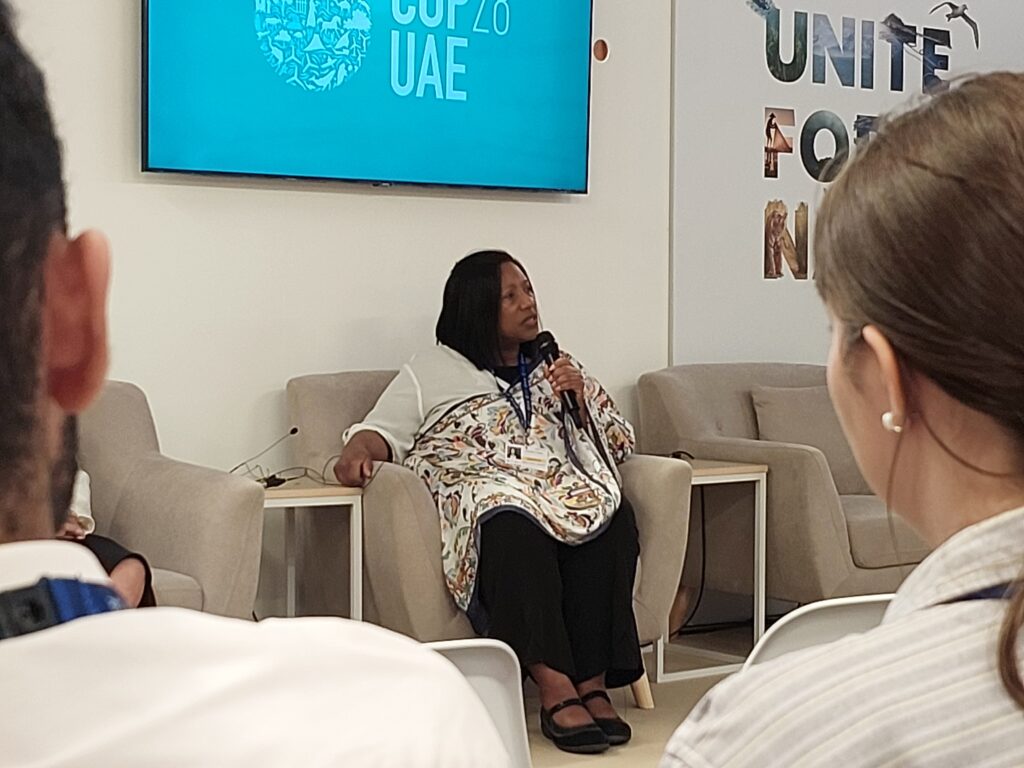By Jasmine Sone
Among all the discussions at COP28, the term “Rights of Nature” caught me off guard, a concept foreign to me until that point. My initial feeling was one of confusion. Why is it necessary to advocate for the Rights of Nature in a world where its intrinsic sacredness should be obvious?
Defining the Rights of Nature involves granting ecosystems legal standing and rights, acknowledging them as entities worthy of protection and preservation. It is a paradigm shift from viewing Nature as property to seeing it as a living being (or collectivity of beings) with inherent rights and respect. The International Union for Conservation of Nature (IUCN) held a fascinating session titled “The Rights of Nature: Towards the Recognition of Ocean’s Rights,” which delves into the critical importance of this viewpoint. The discussion emphasized why respecting Nature’s rights is crucial to our planet’s survival and well-being.
Myra Jackson, one of the speakers and one of the professors for our ongoing class (Community-Based Field Course: COP28 – Dubai, UAE), spoke passionately about the Rights of Nature and their relationship with indigenous peoples. Her statements struck a chord with me because she underlined the essential role of indigenous communities as environmental stewards. She articulated their intimate connection to Nature, where Nature isn’t just a commodity but a living being—a sibling, a guardian— to be protected. Myra’s words rang true: our disconnection from Nature had led us astray. The plea for a holistic, relational approach rang out loud and clear, highlighting the importance of learning from indigenous communities. Earth’s distress signals, backed by scientific findings, demand our attention, pleading to listen, reconnect, and take a comprehensive approach to healing our world. In essence, she emphasized that no rights can exist in isolation—indigenous rights are inseparable from human rights, which are inextricably linked to Nature’s rights. Another speaker, Yenny Vega, an expert in water law, echoed Myra’s remarks, emphasizing that recognizing the Rights of Nature strengthens and reinforces human rights.
Their message stressed the urgent need to adjust our worldview, recognize our interconnectedness with Nature, and recognize that human well-being is inextricably related to the prosperity of the natural world. These insights brought to light the need to adopt a paradigm shift in which the Rights of Nature correspond with human rights, requiring an inclusive, harmonious relationship between people, their rights, and the Rights of Nature.
Listening to the speakers’ profound remarks helped me overcome my initial doubts about the Rights of Nature. Growing up in Myanmar, I was taught that nature is sacred—a realm where nats, god-like spirits, live in mountains, rivers, trees, the air we breathe, and many others. The destruction of these natural elements was interpreted as unleashing the spirits’ wrath on the wrongdoer. In my Burmese heritage, my ancestors had an intrinsic reverence and connection with animals, as seen by our veneration for elephants as sacred beings and the symbolic significance of plants, such as the lotus, in our Buddhist faith.
However, historical accounts written about Myanmar during the British colonial era painted these cultural relationships with animals as disgusting and inappropriate. Regardless of this external perception, I grew up deeply respecting Nature and its significance in our daily existence. We are inextricably intertwined with Nature; while Nature can exist and thrive without us, we cannot exist without Nature. The practice of taking only what we need from Nature and reciprocating with manifold offerings was instilled in me at a young age, which made advocating for the Rights of Nature, at first, confusing.
It wasn’t until COP28 that the puzzle pieces fell into place. Both Myra and Yenny’s insights illuminated a critical point: the disconnect from nature, which is prevalent in the global north, reflects humans generally perceiving themselves as superior. This understanding hit home, highlighting the importance of advocating for the Rights of Nature right now.
This realization was consistent with what I had been taught about the “ko saunt nat,” a guiding spirit that resides within every individual and influences one’s actions toward good. As one deviates from virtuous acts, this spirit drifts away, reminding us of our connection to nature and the consequences of veering from harmony. Thus, safeguarding Nature becomes an extension of safeguarding our spiritual essence. In the same way that neglecting Nature separates us from our inherent goodness, taking care of and protecting nature brings us closer to our innate connection with the natural world.
In essence, the Rights of Nature aren’t simply laws. They’re a realization that protecting Nature isn’t only our duty; it’s also a way to reconnect with our inherent connection with the Earth. It’s a plea to honor indigenous wisdom, take a holistic view, and include Nature’s rights in our shared moral compass. It’s a journey back to understanding that we are not separate from Nature—that we are an intricate part of its fabric and that our well-being is intertwined with her thriving.



